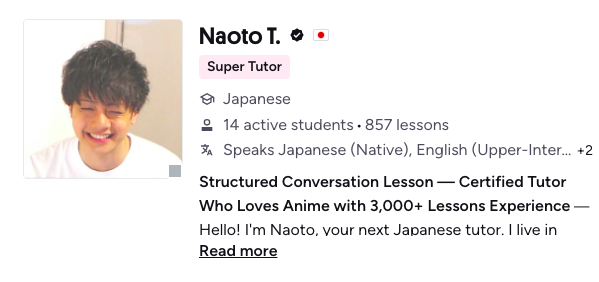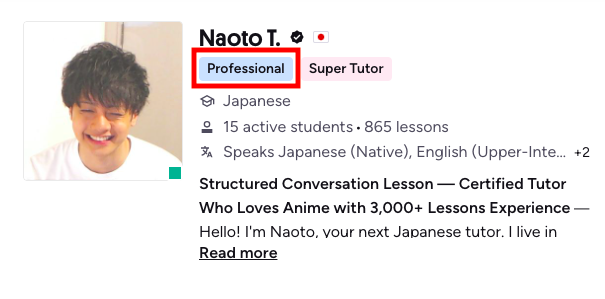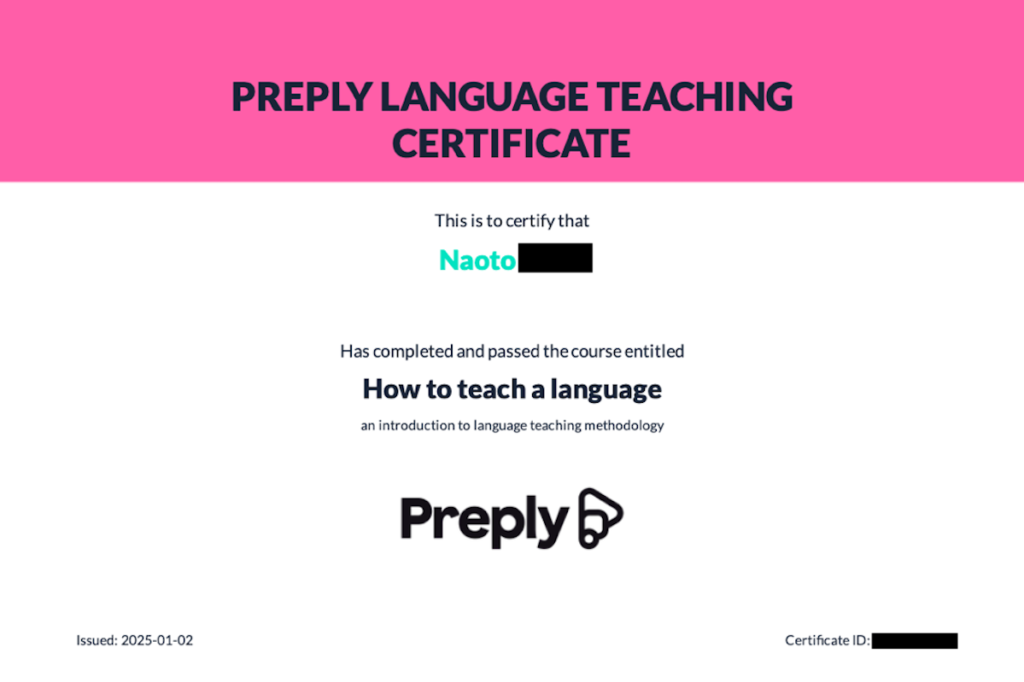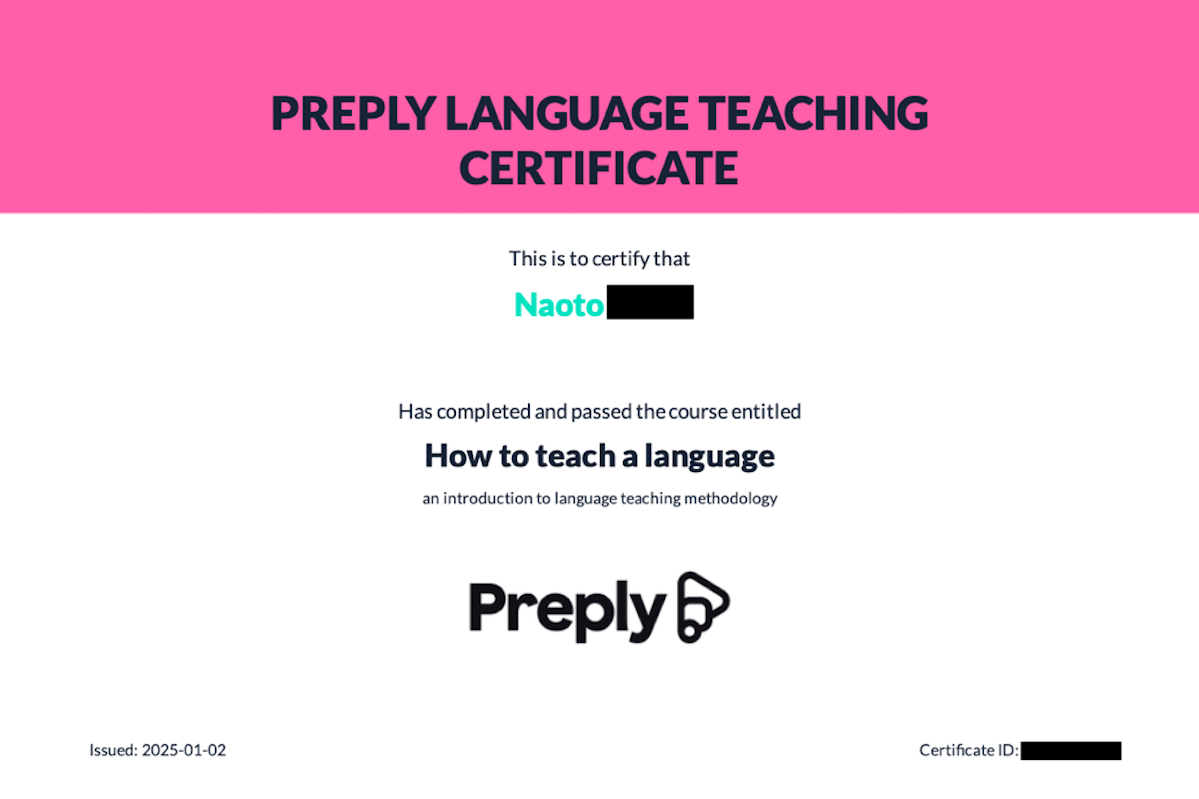As of December 2024, Preply extended its Professional badge to tutors of all languages, a perk that was previously available only to English tutors.
To earn this badge, you need either a certificate issued by a government or a government-accredited institution, or the Preply Language Teaching Certificate.
The first two currently apply only to English tutors. As of now, January 2025, tutors of other languages need to complete the Preply Language Teaching Course to earn the “Professional” badge.
Although I already hold a Japanese Language Teaching Competency Test certification, I wasn’t sure if it would be recognized as fulfilling the requirements for this badge in the future.
With some downtime over the New Year holidays while visiting family, I decided to try the Preply Language Teaching Course myself.
It took about 10 hours to complete, and I’m happy to say that I successfully earned the Professional badge!



*It seems that the badge takes about 2–3 days to show up.
- What Is the Preply Language Teaching Course?
- Surprisingly Good: A Must-Try for New Tutors
- Teaching Methods: Gaining Deeper Understanding Through Experience
- Why I Love Task-Based Language Teaching
- Keeping Lessons Fresh for Tutors
- Ideas That Differed From My Beliefs
- Why Experience Matters More Than Certifications
- Final Thoughts: Highly Recommended for Beginner Tutors
What Is the Preply Language Teaching Course?

This course, offered by the online education platform Preply, is a training program specifically designed for language tutors.
It covers the fundamentals of language teaching and is divided into 12 units across four key topics:
- Student-centered teaching
- Teaching different types of lessons
- Teaching techniques
- Going beyond the first lessons
Surprisingly Good: A Must-Try for New Tutors

I’ll admit, I was initially skeptical about earning a “Professional” badge with just a 10-hour course. But to my surprise, it turned out to be an excellent training program.
Compared to the Japanese Language Teaching Competency Test I completed, which required memorizing plenty of unnecessary details (like the history of Japanese language education and the names of teaching method proponents), this course was refreshingly practical.
Japanese Language Teaching Competency Test designed for group classes, included many concepts that aren’t particularly relevant for online teaching.
In contrast, the Preply course is packed with essential knowledge tailored for next-generation online tutors.
I realized that the basics of online language education are far simpler than I’d imagined. Specifically, the course taught:
- Different approaches to language instruction
- How to effectively provide feedback on learners’ mistakes
The content is practical and immediately useful, especially for tutors who are just starting out.
Keep in Mind: Grammar and Pronunciation Aren’t Covered
Since this course caters to tutors of all languages, it doesn’t include detailed lessons on grammar or pronunciation.
These areas require independent study.
That means completing the course alone won’t make you a “Professional” tutor. Becoming truly professional still requires significant practice and further training.
Teaching Methods: Gaining Deeper Understanding Through Experience
The course provides detailed explanations of various teaching methods and their effectiveness, which is crucial for any language tutor.
Preply’s flexibility allows tutors to teach in their preferred style and learners to choose tutors whose methods align with their learning preferences.
Understanding different teaching styles is essential, and this course introduces several, including:
- PPP (Present, Practice, Produce)
- TTT (Test, Teach, Test)
- TBLT (Task-Based Language Teaching)
- Text-based Presentation
- Flipped Classroom
Interestingly, the outdated Audio-Lingual Method, still found in textbooks like Minna no Nihongo, wasn’t included—likely because it’s no longer considered effective globally.
Why I Love Task-Based Language Teaching
I incorporate Task-Based Language Teaching and Flipped Classroom techniques.
The course included video explanations where one tutor described Task-Based Language Teaching as:
- Fun and engaging.
- Conversation-focused, with no two lessons ever the same.
I couldn’t agree more.
For instance, studying Latin often involves analyzing its grammar like solving a puzzle. While that can be appealing for some, I find it mechanical and dull. It involves presenting problems with fixed answers and teaching all students the same way.
While this helps learners understand language structures, it doesn’t necessarily make them fluent speakers.
Keeping Lessons Fresh for Tutors
In contrast, Task-Based Language Teaching creates dynamic, conversation-based lessons.
For example, if the task is to decide between Tokyo or Kyoto as the next travel destination, students might learn phrases like, “〜の方がいいと思います。(I think ~ is better.)”
The preferences and discussions differ for each student, making every lesson unique. Students’ reasons for their choices also reveal their personal tastes and personalities, leading to richer conversations.
Sometimes, these lessons even spark discussions about their actual travel experiences, creating meaningful and practical learning moments.
For tutors, this approach is equally exciting—no two lessons are alike, even when the topic is the same. This variety keeps teaching fresh and engaging.
The course helped me clearly articulate why I love Task-Based Language Teaching, giving me a better understanding of my own teaching philosophy.
Ideas That Differed From My Beliefs
Not everything in the course aligned with my teaching philosophy, but that’s okay. Teaching methods are not one-size-fits-all; it’s important to adapt them to your style.
For example, the course suggests not correcting all pronunciation mistakes. However, I correct it as much as possible from the beginner stage, since Japanese pronunciation is relatively simple.
I’ve found that this doesn’t frustrate students because my corrections are quick, and it also improves their listening skills.
Of course, some students prefer not to have their pronunciation corrected, so I don’t emphasize it with them. The ideal approach is to tailor the teaching style to each student’s preferences.
Why Experience Matters More Than Certifications
The reason I’ve come to favor Task-Based Language Teaching and prioritize pronunciation correction is because of my own teaching experience.
There are successful tutors who use teaching styles I don’t personally enjoy, which reinforces that there’s no universal “right” method.
The best teaching style is one that suits both you and your students, helping them progress effectively.
To discover what works best, you need to experiment with different approaches yourself.
While studying the theory behind language teaching is important, practical experience is the key to growth.
Taking the Preply Language Teaching Course to learn the essentials and then gaining hands-on experience is probably the fastest way to improve.
Final Thoughts: Highly Recommended for Beginner Tutors
I strongly recommend this course especially for new tutors!
Earning the “Professional” badge is relatively straightforward, but I’m committed to gaining more experience to truly live up to the title.



